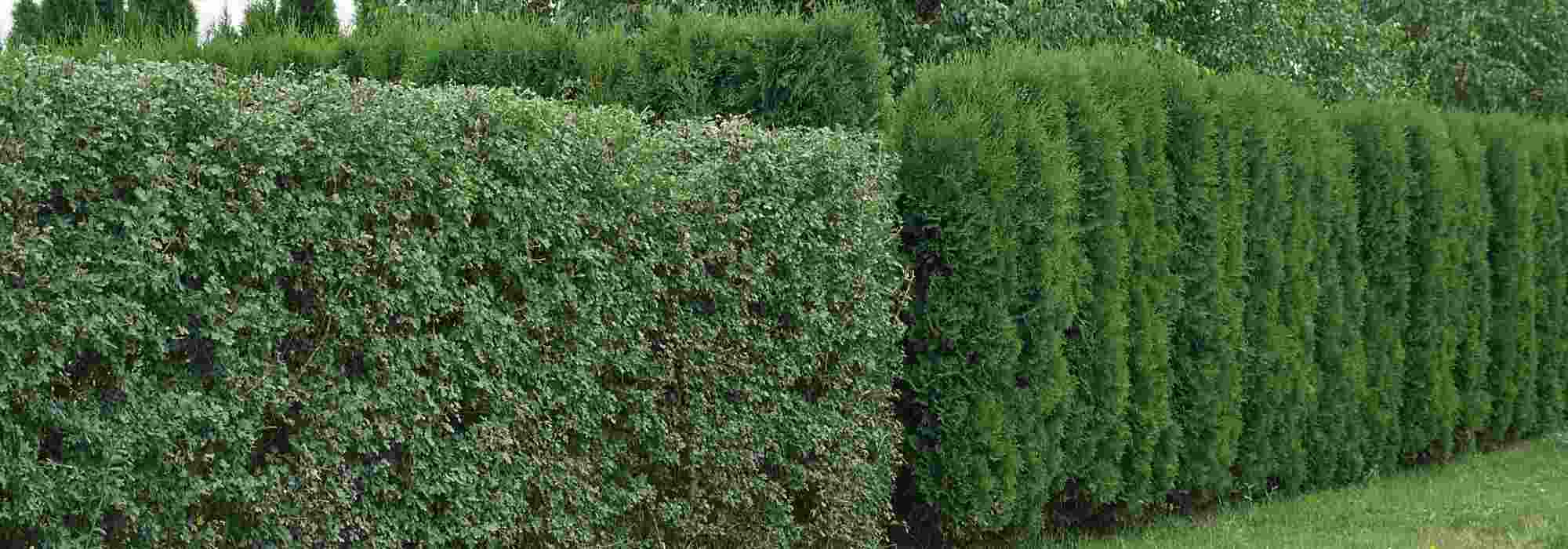
10 best bushes to create a windbreak hedge
Perfect protection...
Contents
A windbreak hedge is essential to protect against the harmful effects of wind: increased impact of cold and drought, delayed growth of some plants, even breakage of branches for the most exposed vegetation… To learn more, discover our advice sheet: How and why to create a windbreak hedge? In short, planting a windbreak hedge will offer a haven of peace to your plants, wildlife and yourselves in the garden.
To achieve an effective windbreak hedge, begin by carefully choosing the bushes that form it: sturdy, hardy plants that resist wind or sea spray and carry evergreen foliage, or at least semi-evergreen or marcescent foliage. But which bushes make a truly effective windbreak hedge? Here is a selection of windbreak bushes best suited to this purpose.
Watch Olivier’s video Why create a windbreak hedge?
Common yew or Taxus baccata, an excellent windbreak bush
Yews are a classic choice for clipped hedging but it must also be said that these trees never go out of fashion. Especially when you consider some varieties that are more interesting aesthetically. Like the cultivar Taxus baccata ‘Semperaurea’, which could be rendered as ‘Always golden’. This yew will retain beautiful yellow to golden tones throughout the year, including winter. This particularly luminous conifer, especially in shaded areas, eventually forms a dense, compact bush, often wider than tall. As yews are dioecious, only female plants bear attractive fruit with bright red arils.
With a moderate growth habit well suited to small gardens: 2.75 m height by 3 m spread when grown singly, stunning year-round, almost maintenance-free, very hardy, adaptable to different soils and climates (north as well as south), this windbreak bush offers many advantages. Pruning is limited to one intervention per year and it can even manage to regrow after a severe cut by sprouting through old wood. It is therefore perfectly suited for a low-maintenance windbreak hedge: very robust, evergreen foliage and only one pruning per season.
Two things to note about yews in general: these plants can live for several centuries and the needles, bark and fruit are toxic to humans and animals (except for birds, which eat the red part of the fruit and discard the seed).
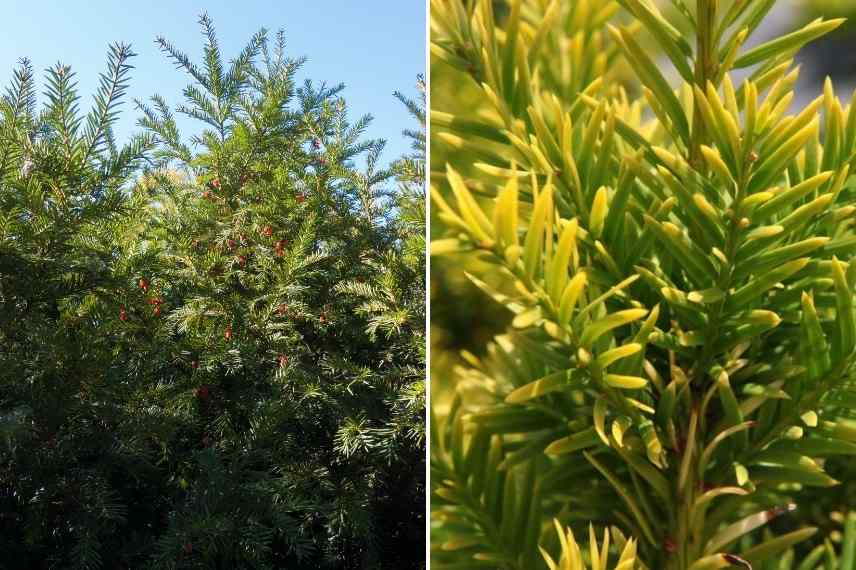
Yew can also be left untrimmed for a hedge; on the right the cultivar ‘Semperaurea’
Chalef or Elaeagnus ebbingei, essential windbreak bush
Elaeagnus or oleaster are bushes with very dense evergreen foliage, often used to form windbreak hedges.
Elaeagnus ebbingei ‘Limelight’ is a variety of Ebbing’s oleaster with leathery, glossy foliage maculate with yellow at the centre on a light green background. This bush thus remains decorative even in winter. Young stems are intensely punctate with bronzed brown, as are juvenile leaves in spring. New shoots lengthen rapidly in spring, with a rust colour and silvery reflections that are highly ornamental.
But oleaster is also prized for its autumn flowering of creamy-white, scented, nectariferous bell-shaped flowers. Afterwards, flowering gives way to edible fruits resembling small olives of coppery and silvery colour.
This type of windbreak bush shows rapid growth and can reach 3 m in height with a 2.50 m spread. Add to that remarkable hardiness, great ability to withstand wind and sea spray and excellent resistance to summer drought: all this makes oleasters a first-rate choice for a windbreak hedge with rapid growth.
Elaeagnus ebbingei ‘Limelight’ is ideal for clipped or unclipped hedges and as a windbreak. It is suitable for warm, dry summer regions and even for a seaside garden, as it tolerates sea spray, but also for more northerly gardens thanks to its hardiness. Note that Elaeagnus possess a root system that can enrich soil by fixing atmospheric nitrogen, somewhat like roots of Fabaceae.
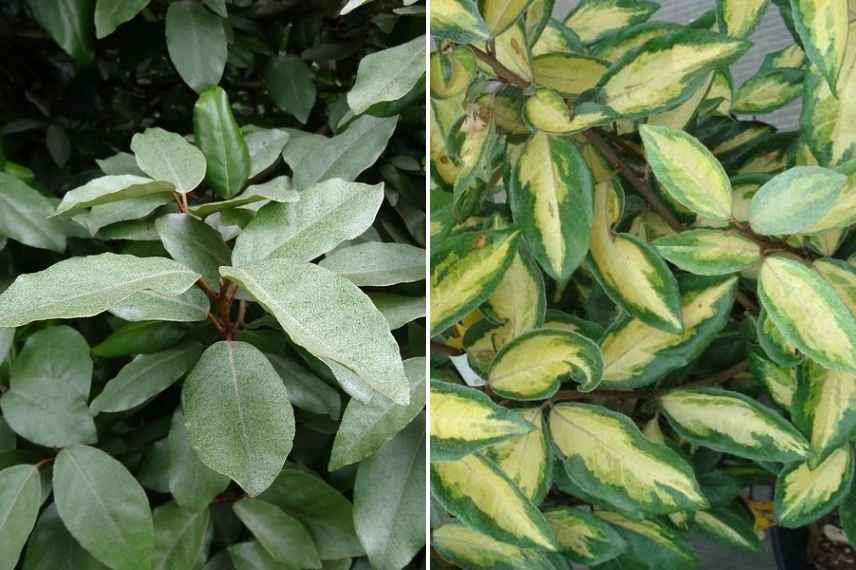
L’Eleagnus ebbingei on left (Photo: O. Titus), and cultivar ‘Limelight’ on right
Discover other Hedge shrubs
View all →Available in 0 sizes
Available in 1 sizes
Available in 1 sizes
Available in 1 sizes
Available in 1 sizes
Available in 1 sizes
Available in 1 sizes
Available in 1 sizes
Available in 2 sizes
Available in 1 sizes
Franchet's Cotoneaster or Cotoneaster franchetii, a windbreak bush
A semi-evergreen bush, useful to wildlife, sturdy and attractive all year round for a windbreak hedge? Why not try Cotoneaster franchetii.
Cotoneaster franchetii is a very hardy bush with rapid growth, undemanding and tolerating pruning very well. These qualities often mean it is used in country hedges or clipped hedges especially when creating a windbreak hedge. Its very dense and semi-evergreen foliage in winter is a considerable asset.
Foliage is very attractive: upper surface is matt green while underside, downy, is silvery white. Its habit is rather irregular: a bush with arching, well-ramified branches. With rapid growth, it develops somewhat shaggy vegetation, broader than tall, but will ultimately reach about 3 m in height with a 3.5 m spread on average if not limited by pruning.
But foliage is not everything! This cotoneaster is also notable for its abundant flowering, starting from May–June and lasting several weeks. The bush then becomes covered with a multitude of pinkish-white, scented and very melliferous flowers, followed by numerous red-orange berries, which remain decorative for a long time in autumn and winter and delight birds.
For cultivation, it is a particularly accommodating bush: any soil suits it provided it is not too dry in summer (even in a fast-growing windbreak hedge). It is also very hardy and can be planted either in full sun or in partial shade.
Cotoneaster franchetii is used both in shrub borders and in free-standing or clipped hedges. But it is a bush that will also perform wonderfully in a large evergreen windbreak hedge. Such a hedge, besides protecting against wind, will also provide food and shelter for much garden wildlife: birds, small mammals, insects…
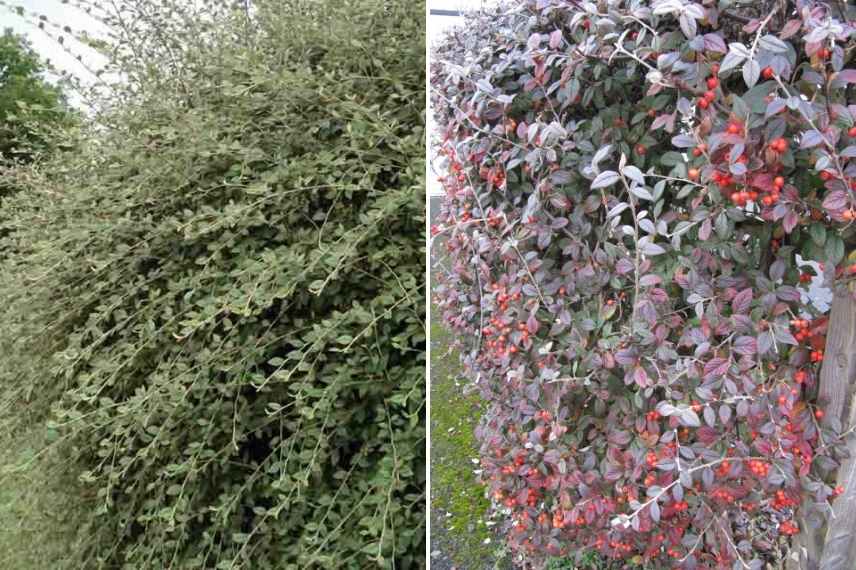
Cotoneaster franchetii, perfect for natural windbreak hedge; red berries brighten winter period (Photo: L. Enking)
St Julian's barberry or Berberis julianae, evergreen windbreak bush
Another handsome bush, both sturdy and offering shelter and food to wildlife for a windbreak hedge: here is Saint Julian’s barberry.
The Berberis julianae is an all-terrain bush, undemanding and maintenance-free. Of medium stature, it forms a slightly upright, particularly dense and very thorny bush that will perform perfectly in a defensive hedge. It is also an excellent windbreak bush, thanks to its bushy, rigid structure. With rather slow growth, it will reach on average 3 m in height and 1.50 m in width at ripeness.
Its evergreen leaves are a glossy dark green, taking a lovely red hue in winter from the first frosts. Its yellow flowering, although fairly discreet, has the wonderful habit of appearing twice a year, in spring (March to May) and again in autumn. Flowers are followed by small fleshy fruits of a pruinose blue, turning black at ripeness.
In garden, it is a trouble-free plant, hardy and highly adaptable. It tolerates all exposures and a very wide range of soils: even heavy, clayey and calcareous soils. It fits easily into a fast-growing windbreak hedge when paired with more vigorous bushes.
The Berberis julianae is superb in a defensive, evergreen hedge, as effective as it is beautiful all year round. It is also one of the best choices for a windbreak hedge because its naturally compact habit requires no regular pruning; the bush is very hardy and trouble-free and its foliage is evergreen. Unduly overlooked, Saint Julian’s barberry deserves a better place in our gardens.
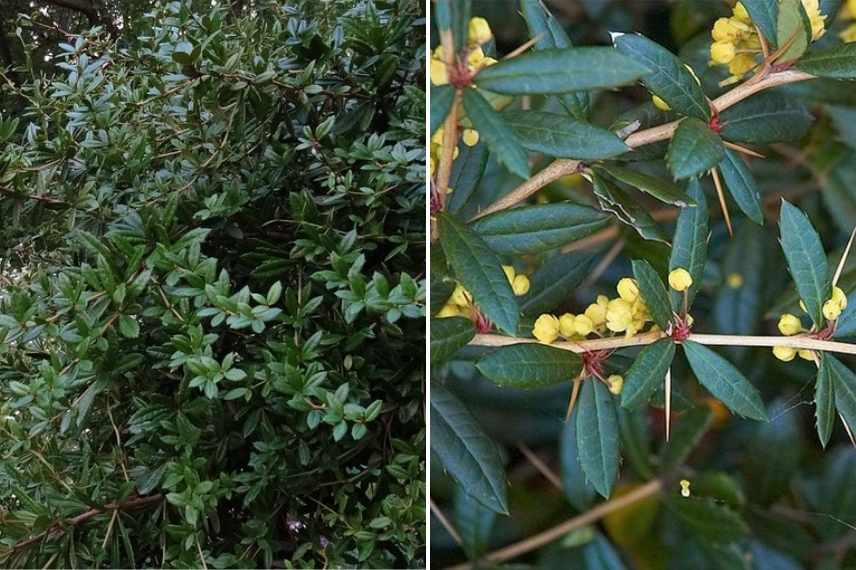
Le Berberis julianae, habit, leaf and spring flowering
Common hornbeam or Carpinus betulus, ideal for windbreak hedges
It is not an evergreen and… it is not strictly a deciduous tree. Hornbeam has what is called marcescent foliage: dead leaves remain on tree throughout winter before falling as soon as new leaves appear. In short, hornbeam, like beech, has all the qualities needed for a windbreak hedge.
The Carpinus betulus or Common Hornbeam is the ideal bush to form regular, elegant hedges quickly and at low cost, called “charmilles”, because this tree tolerates even the harshest pruning admirably. It is a very hardy native tree fairly widespread in forests of central Europe. If left to its own devices, the tree can reach 25 m in height in the wild or about ten metres in gardens, but it readily adapts to pruning and its height can easily be reduced to 2 m or even less (indeed hornbeams are well suited to bonsai art…)
Foliage is deciduous and compound, with ovate, dentate leaves of pale green turning yellow‑orange in autumn. Leaves remain attached to twigs during winter, before falling when new leaves emerge in spring: this is known as marcescence. Thanks to its marcescent foliage, a hornbeam hedge has good screening ability, remains decorative throughout year and above all can serve as an effective windbreak hedge.
Hornbeams are naturally undemanding regarding soil and exposure, but are preferably planted in deep, rich, clayey, well‑drained soil, even calcareous.
Did you know? It can sometimes be hard to tell hornbeam from beech just by foliage. Fortunately, there is a little mnemonic: “Le Charme d’Adam et d’Hêtre à poil“. This means hornbeam leaves have small teeth, while beech leaves are villous.
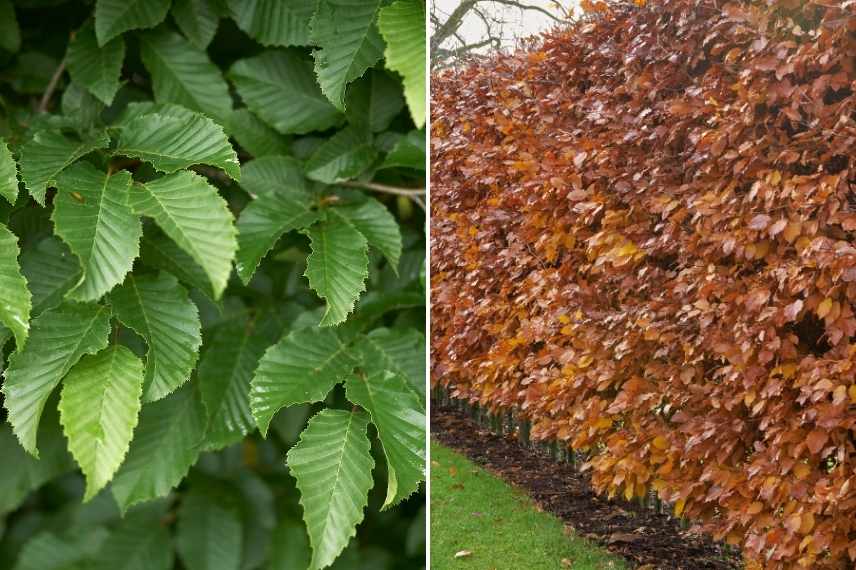
Superb dentate foliage of the hornbeam and winter colouring in coppery tones
Common privet or Ligustrum vulgare, a classic for windbreak hedging
We all know privet, having sometimes seen it too often in hedges, but… it must be acknowledged that this bush performs admirably in a windbreak hedge. Appeal is even greater if you have a lightweight hedge trimmer and allow it the chance to reward you with its flowering and fruiting…
The Ligustrum vulgare ‘Atrovirens’ is an interesting selection for its foliage, which remains more evergreen over winter than the typical species. The foliage of common privet is more semi-evergreen than truly evergreen. Its habit is bushy and ramified, its erect stems are very vigorous, and its growth is rapid, easily reaching 2 to 3 m in height for a width of 1.5 to 2 m. Its foliage, very dense, is made up of narrow, ovate leaves of dark green colour.
Common privet ‘Atrovirens’ offers, in early summer and if left unpruned, a fragrant, cream-white summer flowering that is nectariferous, followed by black berries in autumn, appreciated by birds (birds that also like to nest in its dense branches).
Variety ‘Atrovirens’ is one of the most used for creating clipped hedges or windbreak hedges. Fast-growing, this windbreak bush also tolerates all aspects, all soils even temporarily waterlogged, sea spray, strong winds and copes very well with repeated pruning. Ligustrum vulgare however shows a preference for calcareous, fertile and cool soils. Privet also has very high resistance to pollution and cold.
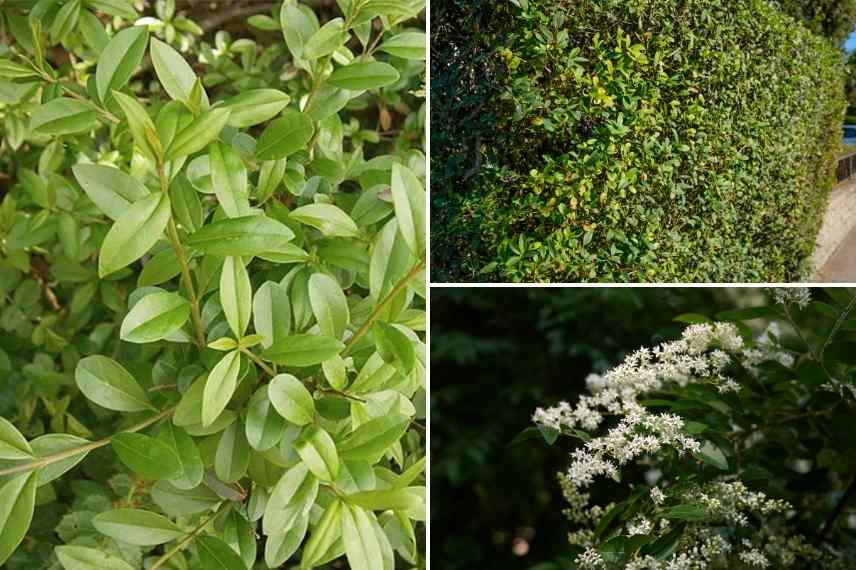
Foliage of privet ‘Atrovirens’ on left; a privet hedge and its flowering if left unpruned, on right
Photinia, a windbreak bush as decorative as it is effective
Another bush that had fallen out of favour. Still suffering from overplanting caused by a fashion trend… Yet Photinias prove as effective in a windbreak hedge as they are beautiful all year round, especially if allowed to flower.
Photinia Fraseri ‘Carré Rouge’ is an evergreen bush with a habit more compact and with denser, more colourful foliage than its cousin ‘Red Robin’. After each pruning, this bush produces young shoots of a particularly vivid cherry-red, developing into shiny, lustrous young leaves among older leaves that have turned green. Photinia ‘Carré Rouge’ displays a naturally compact, very bushy habit and shows rapid growth yet will not exceed 3 m in height by 2 m in spread even without pruning.
In spring (March–April), clusters of small white flowers appear on terminal parts of the shoots. They are slightly scented and attract numerous pollinating insects.
Comfortable in any good garden soil, even by the sea, ‘Carré Rouge’ tolerates all types of well-drained soil, deep, moist to dry in sunny or part-shaded situations. Very calcareous or excessively heavy clay soils should however be avoided. It is a bush that is easy to grow and maintain and can withstand temperatures down to -15°C, as well as conditions typical of a windbreak hedge: strong winds, sea spray, exposed positions. In short, thanks to its moderate development, evergreen foliage and adaptability, Photinia is an excellent choice for creating a fast-growing windbreak hedge that is both elegant and robust.
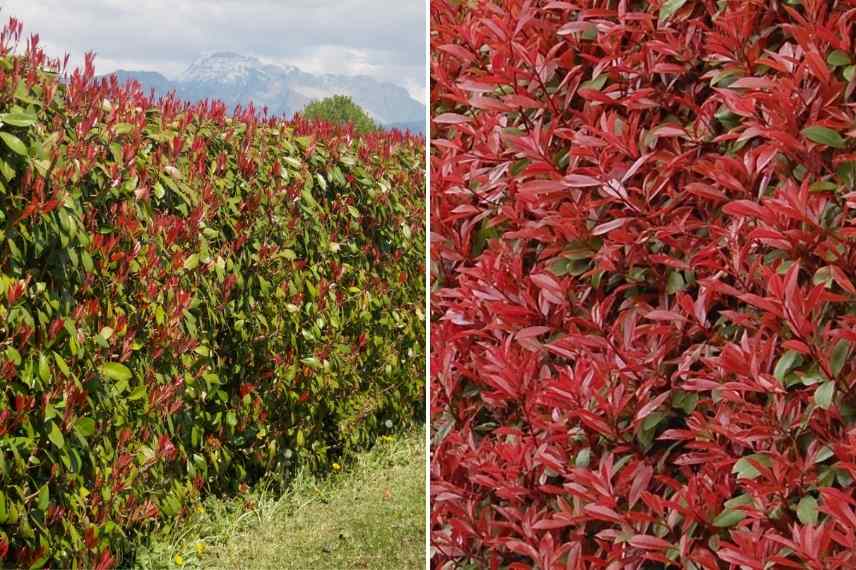
A windbreak hedge of Photinia Fraseri, and on the right the deep red foliage of Photinia ‘Carré Rouge’
Portuguese laurel, an elegant and robust windbreak bush
More elegant and more drought-resistant than cherry laurel (Punus laurocerasus), Portuguese laurel has plenty to offer…
The Prunus lusitanica ‘Brenelia’ is a new introduction considered the most compact and hardiest on the market: this bush can reach 2.5 m in height and 2 m in spread. Although faster-growing than the typical species, it can put on 20 to 30 cm per year once established. This evergreen bush bears glossy dark green foliage with distinctly red petioles, remaining decorative all year round. Red shoots will be much less intense in a shaded position.
It also produces beautiful, long clusters of creamy-white flowers with orange centres in late spring (May–June depending on climate), scented with honey, nectariferous and melliferous. This flowering is followed by production of small ovate berries that are green at first, then red, turning deep purple and finally black in autumn. These berries are highly poisonous to humans if ingested, but much appreciated by certain birds such as magpies and starlings.
Hardy to around −15°C (its hardiness is better in well-drained ground), Portuguese laurel is a low-maintenance, undemanding bush provided it is planted in ordinary soil that is not too dry to moist, even calcareous and well drained. It enjoys ambient humidity and the mildness of an oceanic climate but adapts elsewhere too, even as far as Mediterranean regions if given sufficiently deep soil. Less hardy than its cousin cherry laurel (or laurel palm), it is much more drought-resistant and grows faster.
It is a windbreak bush much appreciated for mixed hedges. Thanks to its ornamental appearance, evergreen foliage, rapid growth and moderate size, Portuguese laurel deserves a place in windbreak hedges, clipped or left untrimmed.

Prunus lusitanica ‘Brenelia’ on left; habit in hedge of a Portuguese laurel and its striking white flowering on right
Escallonia, a small windbreak bush for mild climates
Escallonia is an ornamental bush with rapid growth. Its hardiness, limited to minus 10°C, and its resistance to sea spray make it ideal for planting as an evergreen hedge or windbreak hedge.
Escallonia ‘Donard Seedling’ is a handsome evergreen bush, vigorous and hardy, able to thrive inland, even well away from coastal gardens. Bushy, dense and compact, supported by gracefully trailing branches, the ‘Donard Seedling’ variety forms a ramified bush with a bushy, spreading habit, of fairly rapid growth, which will reach on average 2 m tall at ripeness and 2.5 m wide. Its small leathery ovate leaves with dentate margins are glossy dark green and are set more densely towards tips of shoots.
Escallonia bears in summer a multitude of pink flower buds that open into small lightly scented pale pink flowers, fading almost to white, enclosed at their base in a pink calyx. Flowering takes place from June–July to September depending on climate, sometimes as early as May in warm climates.
Escallonia ‘Donard Seedling’ loves sun, tolerates shade, sea spray, calcareous soils and summer drought once well established. It only fears icy winds and excessively severe winters, especially in poorly drained soil. It is indispensable in seaside gardens because it tolerates sea spray remarkably well and fits perfectly into a windbreak hedge in a mild oceanic climate.
Its moderate development and remarkable resistance allow Escallonia to earn a place on the (long) list of shrubs for windbreak hedges, notably in small gardens and in southern and seaside gardens.
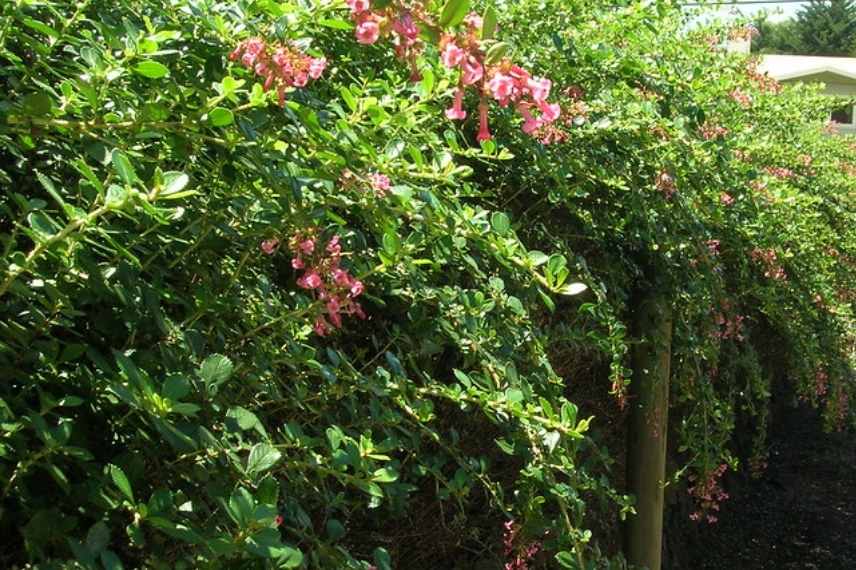
A very pretty Escallonia windbreak hedge
Common holly, a decorative and defensive windbreak bush
Hollies, symbols of winter and year-end festivities, are bushes that give structure to the garden during the cold season and… for the rest of the year too. Their branches of a beautiful dark green, laden with scarlet berries, are a real treat for the eye and for birds that relish them.
Ilex aquifolium ‘Argenteomarginata’ is a bush with striking glossy green foliage variegated with creamy white. Left unpruned, variegated holly can form a small slender tree up to 8 m in height with a spreading of 3 m, with rather slow growth. Foliage of ‘Argenteomarginata’ holly is evergreen, making it an excellent choice for creating a decorative windbreak hedge.
Variegated holly also produces very discreet white flowers that will turn into bright red berries on female specimens. These berries will persist on the plant for almost the whole winter. However: to obtain berries on female specimens, you will need at least one male Ilex aquifolium (or common holly) nearby.
With great hardiness, variegated holly is hardy down to -20°C and performs well in all regions. It tolerates most soils, preferably acidic and well-drained as it copes poorly with heavy soils.
Variegated holly is ideal for small gardens as it responds very well to pruning. C’est un arbuste brise-vent idéal, both defensive, evergreen and ornamental, perfectly suited to creating windbreak hedges that are resilient, long-lasting and attractive.
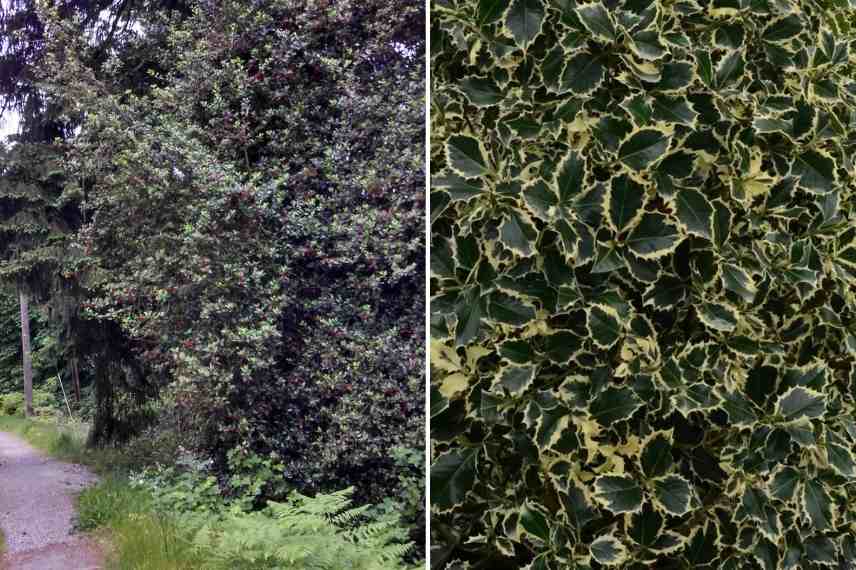
Common holly forms very beautiful hedges that become covered in berries throughout winter (Photo: J. Brew). To the right Ilex aquifolium ‘Argenteomarginata’
- Subscribe!
- Contents
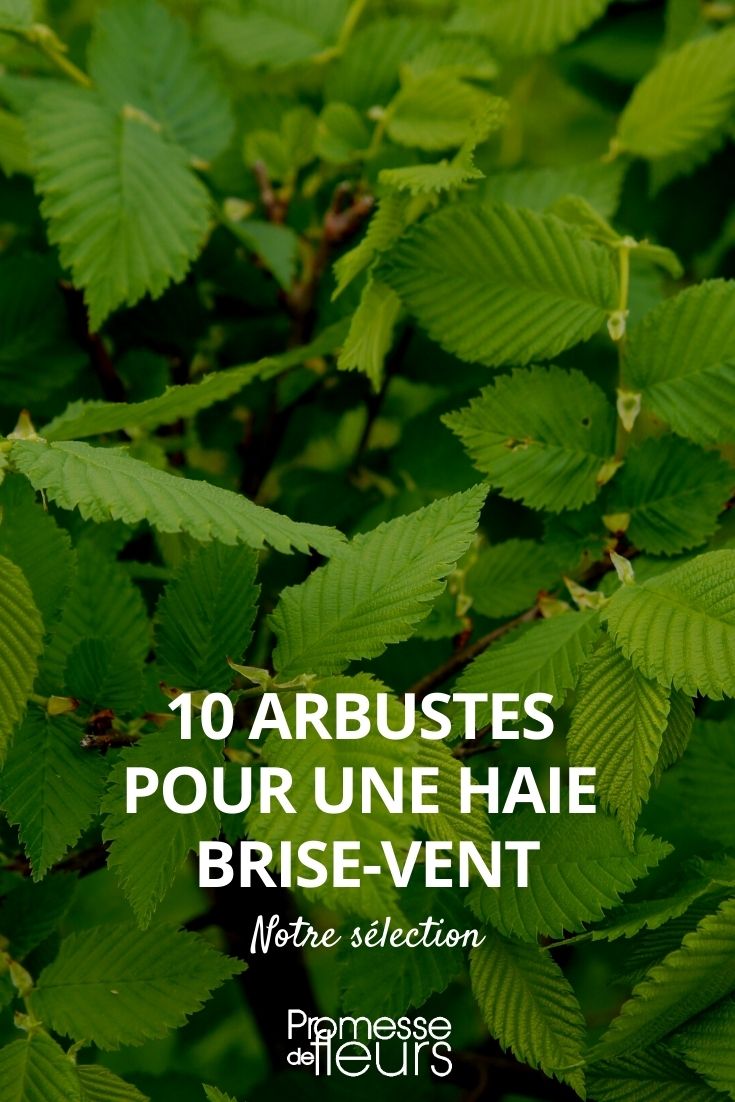



































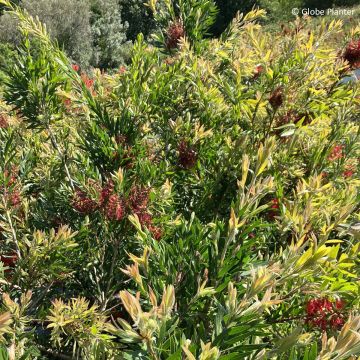
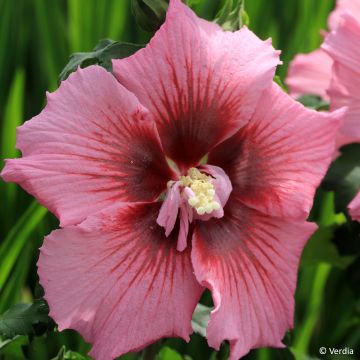
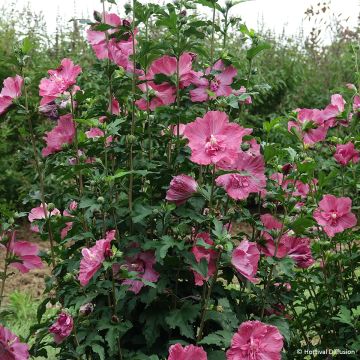


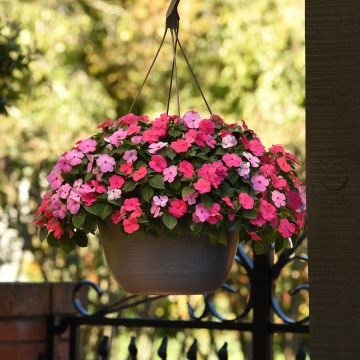
Comments